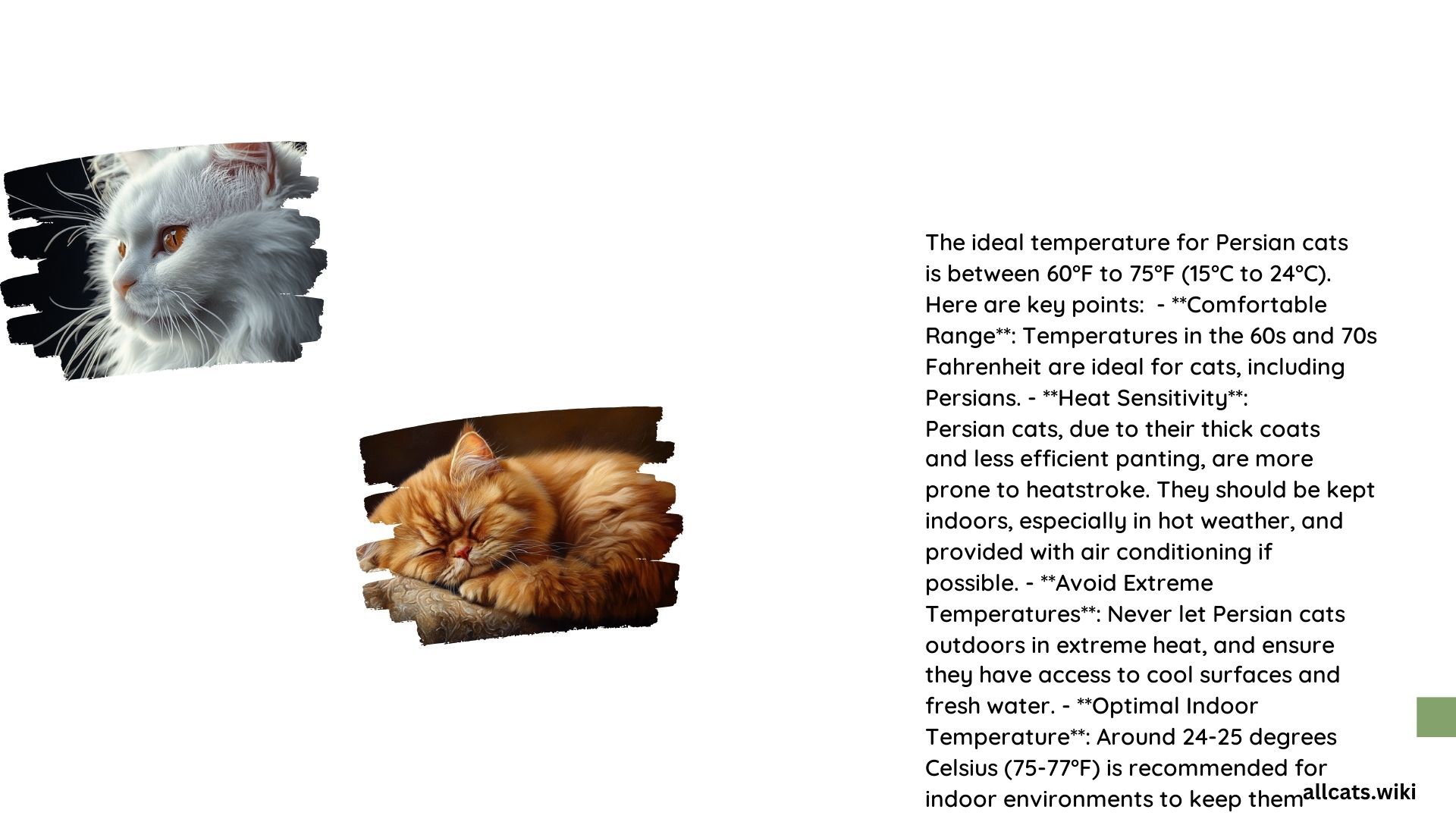Ideal Temperature for Persian Cats
Persian cats, known for their thick fur and flat faces, have specific temperature preferences that are crucial for their comfort and health. The ideal temperature range for Persian cats is generally between 70°F to 75°F (21°C to 24°C), which helps them maintain their body temperature without feeling too hot or too cold.
What is the Optimal Temperature Range for Persian Cats?
The ideal temperature range for Persian cats is between 70°F to 75°F (21°C to 24°C). This range helps them maintain their body temperature without feeling too hot or too cold.
How Can I Maintain the Ideal Environment for My Persian Cat?
- Air Conditioning and Heating Systems:
- In hot weather, air conditioning is essential to keep your Persian cat cool. This breed is particularly susceptible to heatstroke due to their thick coats and inability to pant effectively.
-
During cold weather, ensure your home is warm enough, ideally between 70°F to 75°F, to prevent hypothermia.
-
Monitoring Indoor Temperatures:
-
Use a thermometer to monitor the indoor temperature, especially in areas where your cat spends most of its time. This helps in adjusting the heating or cooling systems accordingly.
-
Adjusting for Seasonal Changes:
-
Adjust your heating and cooling systems based on seasonal changes. For example, in summer, ensure the air conditioning is on, and in winter, use heating to maintain a comfortable temperature.
-
Creating Cozy Resting Spots:
- Provide cozy resting spots with blankets or heated pads. These can help your cat regulate its body temperature and feel more comfortable.
How Does the Thick Fur of Persian Cats Affect Their Temperature Preferences?
- Heat Buffering: The thick fur of Persian cats acts as a buffer between their skin and the environment. However, this fur can also trap heat, making them more prone to heatstroke in hot weather. In cold weather, the fur helps to keep them warm.
- Avoiding Extreme Temperatures: It is crucial to avoid exposing your Persian cat to extreme temperatures. For instance, never leave them outside in direct sunlight or in a parked car, as these conditions can quickly lead to heatstroke.
What Are the Behavioral Signs of Temperature Discomfort in Persian Cats?
- Heatstroke Signs: Watch for signs of heatstroke such as lethargy, panting, sweaty paws, loss of appetite, vomiting, trouble breathing, and redness around the tongue and mouth.
- Cold Stress Signs: If your cat is too cold, it may exhibit signs like shivering, dilated pupils, low heart rate, weak movements, and slow, shallow breathing.
What Products and Materials Can I Use to Maintain the Ideal Temperature for My Persian Cat?
- Fans and Air Conditioners: Use fans and air conditioners to keep your cat cool in the summer.
- Heated Pads and Blankets: Provide heated pads or thick blankets to keep your cat warm in the winter.
- Pet Sunscreen: If your cat must be outside, use pet sunscreen to protect their skin from sunburn, especially if they have been shaved.
Practical Steps to Maintain the Ideal Temperature for Your Persian Cat
- Regular Temperature Checks: Regularly check the indoor temperature to ensure it remains within the comfortable range for your cat.
- Seasonal Adjustments: Adjust your heating and cooling systems according to the season to maintain a consistent and comfortable temperature.
- Cozy Resting Areas: Create cozy resting areas with blankets or heated pads to help your cat regulate its body temperature.
- Monitoring Behavioral Signs: Keep an eye on your cat’s behavior and watch for signs of discomfort due to temperature changes.
Reference Links
- Forever Vets: “How Hot is Too Hot for Cats?” – This article provides detailed information on the temperature range for cats, signs of heatstroke, and how to keep your cat cool.
- Reddit: “How can I cool my Persian cat in these extremely hot days?” – This discussion includes practical tips from cat owners on how to cool down Persian cats in hot weather.
- Hill’s Pet: “What’s a Normal Cat Temperature? Tips for Checking Your Cat’s Vitals” – This article offers guidance on normal cat temperatures and how to check vital signs, which is useful for monitoring your cat’s health in different temperatures.

